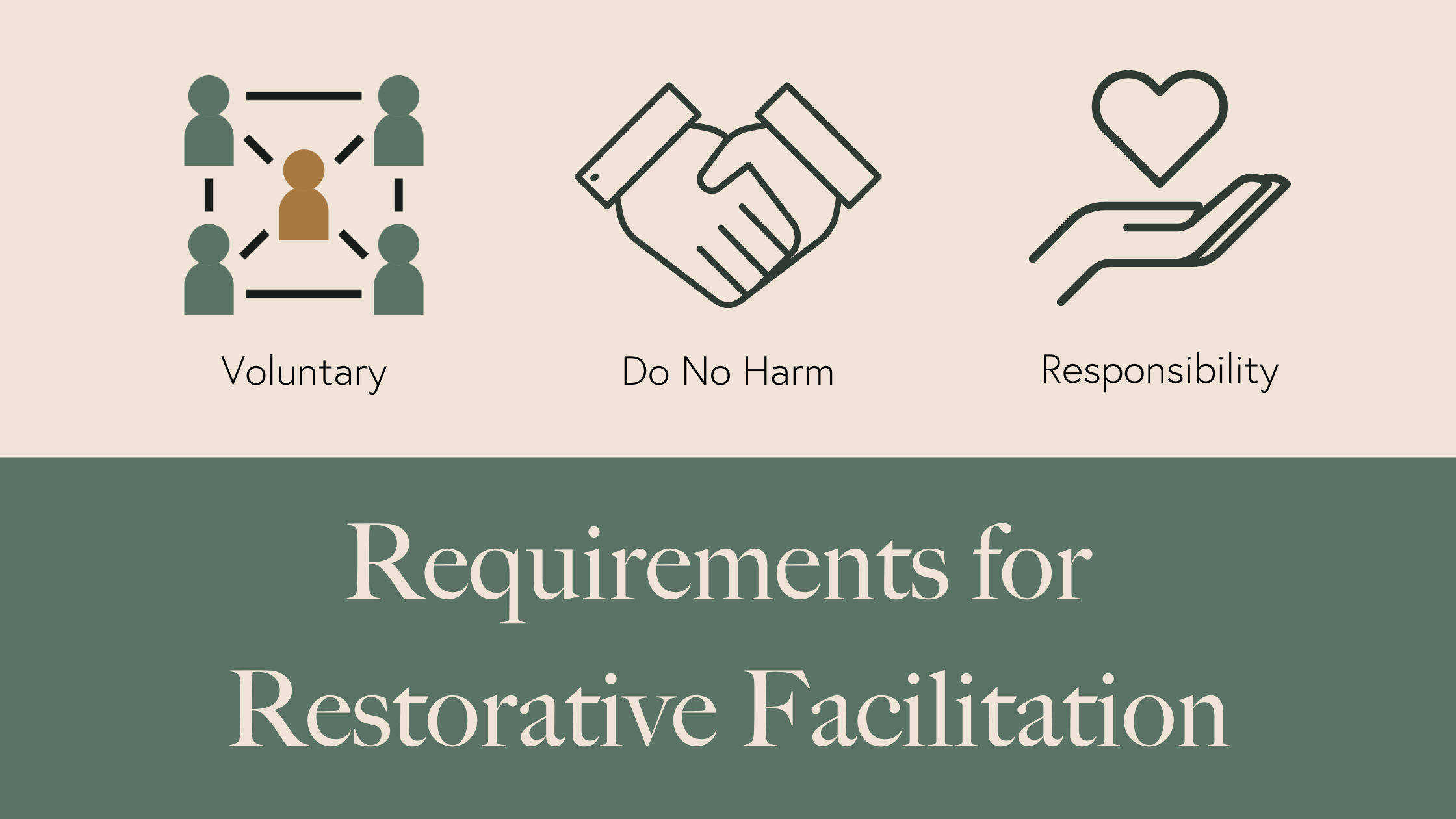Requirements for Restorative Facilitation
At Restorative Services, we work with individuals to determine what they need to address any harm they may be experiencing. Sometimes (though not always), this involves a facilitation with another person or people who may be involved in the issue, incident, or conflict.
If a facilitation has been identified as a possible way to address needs, we must ensure that it will meet three essential criteria for all parties.
First, before bringing people together, we meet separately in private preparation meetings, where we review the three criteria:
1. No further harm should be created by the process; participants’ emotional and physical safety is paramount.
We’re in the business of repairing harm, not causing further harm. While we acknowledge that facilitated conversations about difficult subjects can at times be challenging and uncomfortable, we want to ensure that the process itself does not cause any further harm to anyone involved.
2. Participation is entirely voluntary.
This means that every participant is genuinely there of one’s own accord. Voluntariness is indicated as the primary principle of best practice for restorative justice processes and one that we adhere to in all of our work. As Umbreit & Armour note: “Restorative justice dialogue is a voluntary and consensual process. Indeed, restorative justice mandates that people must choose of their own free will to engage in a dialogue. This position stands in marked contrast to the criminal justice system, which demands attendance at proceedings, compels or disallows speech, and requires behavioral adherence to prescribed rules.”
3. Participants take responsibility for their behaviour and its resulting harm.
We distinguish between intent and impact in restorative practices. We know that we don’t need to have intended to cause harm, and yet we can still be responsible for the harm resulting from our actions. Restorative facilitations require an acknowledgement of impact in order to proceed as a foundation for how we can collaboratively repair any harm in those impacts.
It’s our responsibility as facilitators to ensure these three criteria are met before embarking on a facilitation, and one we take seriously. Unfortunately, this means that sometimes we cannot move forward into a facilitation. If this is the case, where appropriate, we can help redirect the participants and may suggest that parties explore alternative resolution pathways, like an investigation or issue-focused mediation, or it may even result in the relationship ending.
This may seem paradoxical to a restorative approach. After all, the goals of all restorative processes are to repair and prevent harm. Often, the harm being referred to is relational, and therefore its repair is centred on the repair of that relationship. However, this is not always the case. Prof Chris Marshall writes that a core principle of restorative justice – restoring the rightness in relationship – is often misconstrued to be an assumption that a relationship must be restored or that an action is to be forgiven. In a justice sense, restoring rightness means that the wrongs “have been exposed and dealt with, not because new depths of intimacy and respect have arisen.” As Dr Sarah Roth Shank states, “This may mean that the relationship changes to reflect rightness, which may also mean the relationship ends.” Ultimately, we aim to assist participants in restoring rightness in whatever is most appropriate – and safe – for them. If a facilitation meets this objective, then we will proceed contingent on these three criteria.
References:
“In academic discourse as well as in international legislation on restorative justice, three principles are commonly regarded as indispensable to high-quality restorative practices such as victim-offender mediation, conferencing and circles. These are the principles of voluntary participation, the impartiality of the facilitator and the confidentiality of the restorative process (De Mesmaecker, 2013: 334).”
Umbreit, M. & Armour, M. (2011). Restorative justice dialogue: an essential guide for research and practice. New York: Springer Publishing Company. See also UN Handbook on Restorative Justice Programmes, Second Edition (2020).
See Braithwaite, J. (2016). Redeeming the ‘F’ word in restorative justice. Oxford Journal of Law and Religion, 5(1), 79-93; Zehr, H. (2015). The little book of restorative justice, revised and updated. New York: Skyhorse Publishing, Inc.
Marshall, C. (2014). Restoring what? The practice, promise and perils of restorative justice in New Zealand. Policy Quarterly, 10(2), 3-11
Roth Shank, S. (2021). Institutionalizing restorative justice in New Zealand’s criminal justice system: Gains, losses, and challenges for the future (Doctoral dissertation). Te Herenga Waka - Victoria University of Wellington. Wellington, New Zealand.

